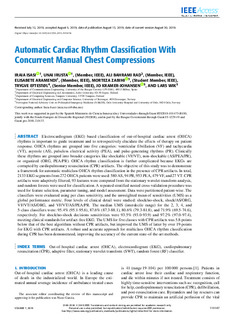| dc.identifier.citation | Isasi, I., Irusta, U., Rad, A.B. et al. (2019) Automatic Cardiac Rhythm Classification With Concurrent Manual Chest Compressions. IEEE Access, 7, 115147-1151159. | nb_NO |
| dc.description.abstract | Electrocardiogram (EKG) based classification of out-of-hospital cardiac arrest (OHCA) rhythms is important to guide treatment and to retrospectively elucidate the effects of therapy on patient response. OHCA rhythms are grouped into five categories: ventricular fibrillation (VF) and tachycardia (VT), asystole (AS), pulseless electrical activity (PEA), and pulse-generating rhythms (PR). Clinically these rhythms are grouped into broader categories like shockable (VF/VT), non-shockable (AS/PEA/PR), or organized (ORG, PEA/PR). OHCA rhythm classification is further complicated because EKGs are corrupted by cardiopulmonary resuscitation (CPR) artifacts. The objective of this study was to demonstrate a framework for automatic multiclass OHCA rhythm classification in the presence of CPR artifacts. In total, 2133 EKG segments from 272 OHCA patients were used: 580 AS, 94 PR, 953 PEA, 479 VF, and 27 VT. CPR artifacts were adaptively filtered, 93 features were computed from the stationary wavelet transform analysis, and random forests were used for classification. A repeated stratified nested cross-validation procedure was used for feature selection, parameter tuning, and model assessment. Data were partitioned patient-wise. The classifiers were evaluated using per class sensitivity, and the unweighted mean of sensitivities (UMS) as a global performance metric. Four levels of clinical detail were studied: shock/no-shock, shock/AS/ORG, VF/VT/AS/ORG, and VF/VT/AS/PEA/PR. The median UMS (interdecile range) for the 2, 3, 4, and 5-class classifiers were: 95.4% (95.1-95.6), 87.6% (87.3-88.1), 80.6% (79.3-81.8), and 71.9% (69.5-74.6), respectively. For shock/no-shock decisions sensitivities were 93.5% (93.0-93.9) and 97.2% (97.0-97.4), meeting clinical standards for artifact-free EKG. The UMS for five classes with CPR artifacts was 5.8-points below that of the best algorithms without CPR artifacts, but improved the UMS of latter by over 19-points for EKG with CPR artifacts. A robust and accurate approach for multiclass OHCA rhythm classification during CPR has been demonstrated, improving the accuracy of the current state-of-the-art methods. | nb_NO |
